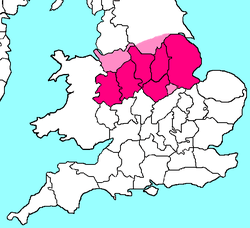North Midlands
The North Midlands is a loosely defined area of England. A statistical definition, first defined in 1881, included the counties of Derbyshire, Leicestershire, Lincolnshire, Nottinghamshire and Rutland as part of the North Midlands region. The region has remained in informal use for Derbyshire and Nottinghamshire, the northern parts of Lincolnshire and Staffordshire, and Cheshire and South Yorkshire to a lesser extent. A combined authority area for the North Midlands was proposed during 2016 for Derbyshire and Nottinghamshire, but was cancelled when the devolution deal for it collapsed later in the year.
North Midlands | |
|---|---|
proposed Combined authority area | |
 Counties typically included in the North Midlands are highlighted in pink. Counties sometimes included in the North Midlands are highlighted in light pink. | |
| Country | |
| Constituent country | |
| Region | East Midlands |
| Counties |
and northern parts of: some definitions include |
| Established | N/A |
| HQ | Nottingham |
| Districts | |
| Government | |
| • Type | Local enterprise partnership |
| • Body | D2N2 Local Enterprise Partnership |
| • Leadership | Chairman and board |
| • Chairman | Peter Richardson |
| Area | |
| • Total | 1,847 sq mi (4,785 km2) |
| Population (mid-2019 est.) | |
| • Total | 1,861,200 |
| Time zone | UTC0 (Greenwich Mean Time) |
| • Summer (DST) | UTC+1 (British Summer Time) |
| Website | www |
History and Extent
A North Midlands region was first defined for the 1881 UK census.[1] It was defined as the entirety of Derbyshire, Leicestershire, Lincolnshire, Nottinghamshire and Rutland. A new definition of the region appeared in 1939, for various government statistical purposes: Derbyshire without High Peak, Leicestershire, Lincolnshire, Nottinghamshire, Rutland and the Soke of Peterborough. In 1942, High Peak was added, but it was removed again in 1946. In 1962, it was merged into a new Midlands statistical region.[2]
The North Midlands has remained in use as an informal term for part of the area, covering Derbyshire and Nottinghamshire, the northern parts of Lincolnshire and Staffordshire, and Cheshire and South Yorkshire to a lesser degree, even though Staffordshire, Cheshire and South Yorkshire never formed part of the statistical region. For example, in the 1960s, Sheffield was described in an official publication as "the vigorous shopping and cultural centre of the North Midlands".[3][4][5]
The introduction to J. B. Priestley's play An Inspector Calls specifies that it is set in the fictional town of Brumley in the North Midlands.
Organisations
The North Midlands Helicopter Support Unit was previously operated jointly by Nottinghamshire and Derbyshire Police until 2013 when all police air support functions were taken over by the newly formed National Police Air Service. The service subsequently closed the North Midlands unit permanently in 2016.[6] The University Hospitals of North Midlands NHS Trust operates in Staffordshire and covers the Royal Stoke University Hospital in Stoke-on-Trent and the Stafford County Hospital.[7]
A North Midlands Combined Authority was proposed to be formed in April 2017. In March 2016 it was reported that plans for a combined authority may not proceed,[8] as South Derbyshire District Council, High Peak Borough Council, Amber Valley Borough Council and Erewash Borough Council had all voted to reject the proposal. In addition, Chesterfield Borough Council decided to sign up to the South Yorkshire Combined Authority, rather than the North Midlands Combined Authority.[9] In July 2016, it was reported that the North Midlands devolution deal had collapsed.[10]
See also
- East Midlands
- South Midlands
- West Midlands
- Northern England
- The Midlands
References
- Woollard, Matthew (1999). "1881 census for England and Wales, the Channel Isles and the Isle of Man: introductory user guide v.0.3" (PDF). University of Essex. Archived from the original (PDF) on December 4, 2013. Retrieved November 15, 2013.
- Hardill, Irene; Benneworth, Paul; Baker, Mark; Budd, Leslie, eds. (2006). The Rise of English Regions?. New York: Routledge. p. 173. ISBN 978-0-41533-632-1.
- Turner, Graham (1967). The North Country. London, UK: Eyre & Spottiswoode. p. 15.
- "Nottinghamshire and Derbyshire launch 'North Midlands' devolution deal". BBC News. BBC News. Retrieved 1 May 2020.
- Ingram, Harold (1948). North Midland Country: A Survey of Cheshire, Derbyshire, Leicestershire, Nottinghamshire and Staffordshire. London, UK: B. T. Batsford. pp. 0–116. Retrieved 31 July 2019 – via Google Books.
- "Police helicopter service to close Derbyshire base to save cash". Derby Telegraph. 20 February 2015.
- "New NHS Trust to run mid and north Staffordshire hospital". NHS Stafford and Surrounds. 13 October 2014. Retrieved 15 February 2019.
- Charity, Nick (4 March 2016). "Plans for combined Notts and Derby mayor could be scrapped". Mansfield and Ashfield Chad. Retrieved 11 May 2016.
- "Derbyshire and Nottinghamshire combined authority a step nearer despite setbacks". Derby Telegraph. Retrieved 11 May 2016.
- Scott, Jennifer (21 July 2016). "Devolution is dead - so what is the plan for Nottingham's future?". Nottingham Post. Retrieved 14 February 2017.
External links